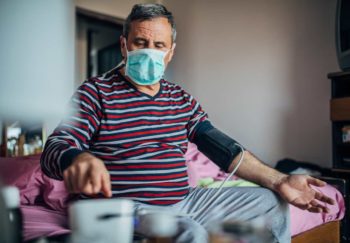My teenage son is a huge fan of European professional soccer. So on June 12, I was watching – along with millions of people around the world – the Denmark vs. Finland game that none of us will ever forget: In the first half of the game, Christian Eriksen, a 29-year-old soccer star, stumbled and fell face down.
His heart had stopped pumping blood. He was in cardiac arrest.
Within seconds, a medic was performing chest compressions. Eriksen’s heart was then given a bolt of electricity from an AED (automated external defibrillator). After several nail-biting minutes, medics took Eriksen off the pitch on a stretcher. He waved to fans as he left.
All of this was caught on camera. While it was traumatic to watch, it taught us two powerful lessons, says cardiologist Pamela Mason, MD:
- Cardiac arrests can happen without warning, regardless of whether the person is young or older and regardless of their health condition.
- Survival is possible with appropriate and quick therapy. Hands-only chest compressions do keep people alive.
Cardiac Arrest: Major Cause of Preventable Deaths
More than 475,000 Americans die each year from sudden cardiac arrest.
“Christian Eriksen survived, probably without any injury, because paramedics and trainers responded immediately. But what those trained professionals did is the same thing that Jane or Joe public, or any bystander, can do,” says emergency medicine physician William J. Brady, MD.
Cardiac Arrest vs. Heart Attack
You might confuse cardiac arrest with a heart attack. A heart attack happens when the heart muscle is damaged because of a blocked blood vessel. This can trigger a fatal cardiac arrest.
“Starving the heart muscle of blood can induce a dangerous arrhythmia (irregular heartbeat). People will say, ‘A person died suddenly of a heart attack,’ but they actually died from a cardiac arrest,” Mason explains.
What is Ejection Fraction, and Why Does it Matter?
Those most at risk for a sudden cardiac arrest have a low ejection fraction — a measure of the pumping strength of the heart. “A normal ejection fraction is 55% to 60%. When patients get down to 35%, we worry they are at risk for sudden cardiac arrest,” Mason says.
“It’s easy to measure an ejection fraction and determine if they could benefit from an implantable cardioverter defibrillator (ICD),” she adds. This device sends an electrical shock to the heart if it stops beating.
“At UVA Health, we have a team of doctors who are experts in implanting these devices and following these patients over time,” Mason says. “Our device clinic operates five days a week and is staffed by nurses, specially certified in device management and programming.”
Why Did Christian Eriksen Come Close to Death?
“The vast majority who experience a cardiac arrest would be people we would expect: They have a prior history of heart attack or heart failure,” Mason says. “When we see young people have a cardiac arrest, they typically have an undiagnosed cardiac condition or have some sort of genetic abnormality that runs in families.”
Ventricular fibrillation, a type of heart rhythm disruption, occurs when the electrical signals that make the heart pump become rapid and malfunction. This triggered Eriksen’s cardiac arrest.
“With a ventricular fibrillation, there is almost never any warning. You can be going along just fine, playing a soccer match. Then, suddenly your heart’s electrical signals malfunction,” explains Mason, who specializes in heart rhythm disorders.
Underlying genetic conditions can cause:
- Dangerous structural changes to the heart
- Disruptions to the electrical signaling
Passing out: A Red Flag
When an otherwise healthy person faints during physical exertion, get an evaluation to uncover a possible genetic heart condition.
Mason says it’s most likely that Eriksen had an electrical signaling problem that wouldn’t show up on imaging scans. These can run in families. People can also get a spontaneous genetic mutation that disrupts the heart’s electrical system.
Days after Eriksen collapsed, doctors still didn’t know exactly what led to his cardiac arrest. But to keep him safe, doctors implanted a tiny defibrillator to automatically restart his heart, if needed.
“It is unlikely he will return to play at the professional level,” Mason says.
“What we saw on TV was traumatic. You won’t want to see that again, so a lot of sports clubs wouldn’t allow him to play.”
You Can Save a Life
Only 8% of Americans survive cardiac arrest outside a hospital. If you spot a teenager or adult who is unconscious and not breathing normally, call 911 immediately, then:
- Place your hands in the center of the person’s chest and push hard and fast (about 110 beats per minute). “Press the chest a little bit more than two inches with each compression. Keep your hands on the chest but release pressure each time so the chest cavity can expand,” says Brady.
- Don’t be afraid to use an automated external defibrillator (AED), widely available at airports, malls, gyms, and school and professional sports complexes.
“AEDs were designed for third graders to be able to operate,” Mason notes.
Not all heart rhythm disruptions that stop the heart require a shock with an AED, adds Brady, who co-authored a New England Journal of Medicine article on bystander intervention. “If the AED tells you to shock, you shock. If it says do chest compressions, just do those. You can rely 100 percent on what an AED says.”
Learn more from the American Heart Association.


